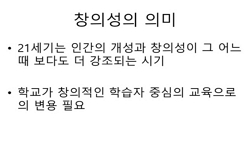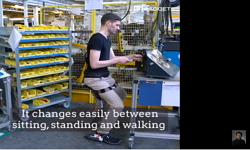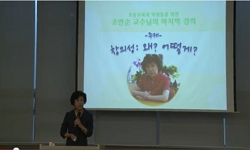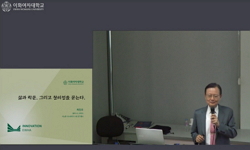본 연구는 다양성에 관한 기존 연구를 종합․분석하여 팀 다양성의 긍정적, 부정적 효과에 대한 포괄적 논의를 통해 몇 가지 연구명제를 도출하였다. 다양성의 유형(사회범주 다양성과 ...
http://chineseinput.net/에서 pinyin(병음)방식으로 중국어를 변환할 수 있습니다.
변환된 중국어를 복사하여 사용하시면 됩니다.
- 中文 을 입력하시려면 zhongwen을 입력하시고 space를누르시면됩니다.
- 北京 을 입력하시려면 beijing을 입력하시고 space를 누르시면 됩니다.
https://www.riss.kr/link?id=A76598003
- 저자
- 발행기관
- 학술지명
- 권호사항
-
발행연도
2009
-
작성언어
-
- 주제어
-
KDC
325
-
등재정보
KCI등재
-
자료형태
학술저널
- 발행기관 URL
-
수록면
95-125(31쪽)
-
KCI 피인용횟수
16
- 제공처
- 소장기관
-
0
상세조회 -
0
다운로드
부가정보
국문 초록 (Abstract)
본 연구는 다양성에 관한 기존 연구를 종합․분석하여 팀 다양성의 긍정적, 부정적 효과에 대한 포괄적 논의를 통해 몇 가지 연구명제를 도출하였다. 다양성의 유형(사회범주 다양성과 정보 다양성)에 따라 주요 결과 변수라 할 수 있는 응집성과 창의성에 미치는 영향을 살펴보았다. 또한 다양성이 성과에 미치는 영향과정을 관리할 수 있는 메커니즘으로서 팀 가치공유의 조절기능을 탐색해 보았다. 제시된 명제를 바탕으로 이론적 의미와 미래 연구방향을 제시하였다.
다국어 초록 (Multilingual Abstract)
First of all, the study has examined the relationship between each type of team diversity(Informational diversity and social category diversity) classified in terms of visibility and job-relatedness, and key performance variables(Cohesion and creativity). In particular, the study went further to look into the relations between diversity and social cohesion, which is an affective bond, as well as task cohesion, which can be achieved from a cognitive perspective. Another issue that was touched upon was a team’s value-sharing, its content and intensity as another important variable that can moderate and manage negative and positive impact of diversity on performance.
Through the discussions, the study has developed the following propositions. First, though diversity has negative implications for social cohesion and task cohesion, social category diversity that produces a big effect on the affective scales and informational diversity with a great cognitive effect each has a negative impact on social cohesion and task cohesion respectively. Second, though both social category diversity and informational diversity have a positive impact on team creativity, informational diversity should play a more positive role. Third, content and intensity of a team’s value-sharing will act in a way that reduces the negative impact of the relationship between diversity and cohesion but that magnifies the positive impact of the relations between diversity and creativity.
Growing diversity has become increasingly important in recent years for organizations. Many researches on diversity, however, have yielded mixed results regarding correlation between team diversity and performance. This study has sought to derive prop...
Growing diversity has become increasingly important in recent years for organizations. Many researches on diversity, however, have yielded mixed results regarding correlation between team diversity and performance. This study has sought to derive propositions through extensive discussions into the effects of diversity based on existing studies.
First of all, the study has examined the relationship between each type of team diversity(Informational diversity and social category diversity) classified in terms of visibility and job-relatedness, and key performance variables(Cohesion and creativity). In particular, the study went further to look into the relations between diversity and social cohesion, which is an affective bond, as well as task cohesion, which can be achieved from a cognitive perspective. Another issue that was touched upon was a team’s value-sharing, its content and intensity as another important variable that can moderate and manage negative and positive impact of diversity on performance.
Through the discussions, the study has developed the following propositions. First, though diversity has negative implications for social cohesion and task cohesion, social category diversity that produces a big effect on the affective scales and informational diversity with a great cognitive effect each has a negative impact on social cohesion and task cohesion respectively. Second, though both social category diversity and informational diversity have a positive impact on team creativity, informational diversity should play a more positive role. Third, content and intensity of a team’s value-sharing will act in a way that reduces the negative impact of the relationship between diversity and cohesion but that magnifies the positive impact of the relations between diversity and creativity.
목차 (Table of Contents)
- 국문초록
- Ⅰ. 서론
- Ⅱ. 팀 다양성의 부정적 효과
- Ⅲ. 팀 다양성의 긍정적 효과
- Ⅳ. 팀의 가치공유와 다양성 효과의 조절
- 국문초록
- Ⅰ. 서론
- Ⅱ. 팀 다양성의 부정적 효과
- Ⅲ. 팀 다양성의 긍정적 효과
- Ⅳ. 팀의 가치공유와 다양성 효과의 조절
- Ⅴ. 결론 및 시사점
- 참고문헌
- 영문초록
참고문헌 (Reference)
1 최종인, "집단 창의성의 결정요인에 관한 연구" 고려대학교 1995
2 Richard, O.C., "the impact of human resource diversity practices on firm performance" 13 (13): 177-195, 2001
3 O'Reilly C.A., "Work group demography, social integration, and turnover" 34 (34): 21-37, 1989
4 Lincoln, J.R., "Work and friendship ties in organizations: A comparative analysis of relational networks" 24 : 181-199, 1979
5 Jehn, K.A., "Why differences make a difference: A field study of diversity, conflict, and performance in workgroups" 44 (44): 741-763, 1999
6 Sanchez-Mazas, M., "When the outgroup becomes the ingroup and when the ingroup becomes the outgroup : Xenophobia and social categorization in a resource allocation task" 24 : 417-423, 1994
7 Leonard, D., "When Sparks Fly: Igniting Creativity in Groups" Harvard Business School Press 1999
8 Muchinsky, P.M., "What is person-environment congruence Supplementary versus complementary models of fit" 31 (31): 268-277, 1987
9 McGrath, J.E., "Traits, expectations, culture, and clout: the dynamics of diversity in work groups, In in work teams: Research paradigms for a changing workplace" APA Publications 1995
10 Woodman, R.W., "Toward a theory of organizational creativity" 18 : 293-332, 1993
1 최종인, "집단 창의성의 결정요인에 관한 연구" 고려대학교 1995
2 Richard, O.C., "the impact of human resource diversity practices on firm performance" 13 (13): 177-195, 2001
3 O'Reilly C.A., "Work group demography, social integration, and turnover" 34 (34): 21-37, 1989
4 Lincoln, J.R., "Work and friendship ties in organizations: A comparative analysis of relational networks" 24 : 181-199, 1979
5 Jehn, K.A., "Why differences make a difference: A field study of diversity, conflict, and performance in workgroups" 44 (44): 741-763, 1999
6 Sanchez-Mazas, M., "When the outgroup becomes the ingroup and when the ingroup becomes the outgroup : Xenophobia and social categorization in a resource allocation task" 24 : 417-423, 1994
7 Leonard, D., "When Sparks Fly: Igniting Creativity in Groups" Harvard Business School Press 1999
8 Muchinsky, P.M., "What is person-environment congruence Supplementary versus complementary models of fit" 31 (31): 268-277, 1987
9 McGrath, J.E., "Traits, expectations, culture, and clout: the dynamics of diversity in work groups, In in work teams: Research paradigms for a changing workplace" APA Publications 1995
10 Woodman, R.W., "Toward a theory of organizational creativity" 18 : 293-332, 1993
11 Smith, K.G., "Top management team demography and process: The role of social integration and communication" 39 (39): 412-438, 1994
12 Wiersema, M.F., "Top management team demography and corporate strategic change" 35 : 91-121, 1992
13 Bantel, K.A., "Top management and innovations in banking: Does the composition of the top team make a difference" 10 : 107-124, 1989
14 Jehn, K.A., "To agree or not to agree: Diversity, conflict, and group outcomes" 8 : 287-306, 1997
15 Harrison, D.A., "Time, teams, and task performance: Changing effects of surface- and deep-level diversity on group functioning" 45 : 1029-1045, 2002
16 West, M.A., "The social psychology of innovation in groups, in Innovation and creativity at work: Psychological and organizational strategies" Wiley 309-334, 1990
17 Tajfel, H., "The social identity theory of intergroup behavior, In Psychology of Intergroup Relations" Nelson-Hall 33-47, 1986
18 Enz, C., "The role of value congruity in intraorganizational power" 35 : 504-529, 1988
19 Mullen, B., &, "The relation between group cohesiveness and performance: An integration" 115 (115): 210-227, 1994
20 Ely, R.J., "The power in demography: Women's social constructions of gender identity at work" 38 (38): 589-634, 1995
21 Hambrick, D.C., "The influence of top management team heterogeneity on firms’ competitive moves" 41 (41): 659-684, 1996
22 Glick, W.H., "The impact of upper-echelon diversity on organizational performance, in Organizational change and redesign: Ideas for insights for improving Performance" Oxford University Press 1993
23 Thatcher, S.M.B., "The impact of individual demographic differences, group diversity, and conflict on individual performance" 1998
24 Becker, B., "The impact of human resource management on organizational performance: Progress and prospects" 39 (39): 779-801, 1996
25 Zaccaro, S.J., "The effects of task and interpersonal cohesiveness on performance of a disjunctive group task" 18 : 837-851, 1988
26 Tolbert, P.S, "The effects of group proportions on group dynamics, In Diversity in work teams: Research paradigms for a changing workplace" American Psychological Association 131-159, 1995
27 Carron, A.V., "The development of an instrument to measure cohesion in sport teams: The Group Environment Questionnaire" 7 : 244-266, 1985
28 Feldman, D.C., "The development and enforcement of group norms" 9 : 47-53, 1984
29 Amabile, T.M., "The atmosphere of pure work: Creativity in research and development, in The Social Psychology of Science" Guilford Press 316-328, 1994
30 Beach, L., "The Psychology of Decision Making in Organizations" Sage Publications 1997
31 Nonaka, I., "The Knowledge-Creating Company" Oxford University Press 1995
32 Kochan, T., "The Effect of diversity on business Performance, Diversity Research Network"
33 Jehn, K.A, "The Dynamic Nature of Conflict: A longitudinal study of intragroup conflict and group performance" 2001
34 Byrne,D, "The Attraction Paradigm,New" Academic Press 1971
35 Devine, D.J., "Teams in organizations: Prevalence, characteristics, and effectiveness" 30 : 678-711, 1999
36 Cady, S.H., "Team innovation and perceptions of consideration: What difference does diversity make" 30 (30): 730-750, 1999
37 Jackson, S.E, "Team composition in organizations, In Group process and productivity" Sage publications 1992
38 West, M.A., "Sparkling fountains or stagnant ponds:An integrative model of creativity and innovation implementation in work groups,Applied" 51 : 355-424, 2002
39 Ashforth, B.E., "Socialization tactics: Longitudinal effects on newcomer adjustment" 39 : 149-178, 1996
40 South, S.J., "Social structure and ntergroup interaction: Men and women of the federal bureaucracy" 47 : 587-599, 1982
41 Festinger, L., "Social pressures in informal groups" Stanford University Press 1950
42 Ashforth, B.E., "Social identity theory and the organization" 24 (24): 20-39, 1989
43 Stroessner, S.J., "Social categorization by race or sex: Effects of perceived non normalcy on response times" 14 : 247-276, 1996
44 Nahapiet, J., "Social capital, intellectual capital, and the organizational advantage" 23 (23): 242-266, 1998
45 Milliken, F.J., "Searching for common threads: Understanding the multiple effects of diversity in organizational groups" 21 (21): 402-433, 1996
46 Barrick, M.R., "Relating member ability and personality to work-team processes and team effectiveness" 83 : 377-391, 1998
47 Jackson, S.E., "Recent research on team and organizational diversity: SWOT analysis and implications" 29 : 801-830, 2003
48 Hoffman, L.R., "Quality and acceptance of problem solutions by members of homogeneous and heterogeneous groups" 62 : 401-407, 1961
49 Kristof, A.L., "Person-organization fit: An integrative review of its conceptualizations, measurement, and implications" 49 (49): 1-49, 1996
50 Klimoski, R.J., "Person perception in organizations: An overview of the field, in people evaluate others in organizations: Person perception and interpersonal judgement in I/0 Psychology" Lawrence Erlbaum 2001
51 Alagna, S.W., "Perceptions of Functioning in Mixed-sex and Male Medical Training Groups" 57 : 801-803, 1982
52 Eisenhardt, K.M., "Organizational growth: Linking founding team, strategy, environment, and growth among US semiconductor ventures, 1978-1988" 35 (35): 504-529, 1990
53 Zenger, T.R., "Organizational demography: The differential effects of age and tenure distribution on technical communications" 32 (32): 353-376, 1989
54 Wiersema, M.F., "Organizational demography in Japanese firms: Group heterogeneity, individual dissimilarity, and top management team turnover" 36 (36): 996-1025, 1993
55 Zaccaro, S.J., "Nonequivalent association between forms of cohesiveness and group-related outcomes: Evidence for multidimensionality" 131 (131): 387-399, 1991
56 McGrath, J.E., "No one has it but all groups do: Diversity as a collective, complex, and dynamic property of groups, In Diversity in Work Teams: Research Paradigms for a Changing World" APA Publications 42-66, 1996
57 Dougherty, D., "New Products in Old Organizations: The Myth of the Better Mousetrap in Search of the Beaten path" M.I.T 1987
58 Reagans, R.E., "Networks, diversity and performance: The social capital of R&D teams" 12 : 502-518, 2001
59 Northcraft, G.B., "Neale, M.A., & Kramer, R.M.(1995), Diversity, social identity and performance: Emergent social dynamics in cross-functional teams, In Diversity in work teams" APA Publications 1995
60 Nemeth, C.J., "Minority influence, divergent thinking and detection of correct solutions" 17 : 786-797, 1987
61 Joshi, A., "Managing workforce diversity to enhance cooperation in organizations, In" Wiley 277-296, 2003
62 Kossek, E., "Managing diversity: Human resource strategies for trans-forming the workplace" Blackwell 1996
63 Simons, T., "Making use of difference: Diversity, debate, and decision comprehensiveness in top management teams" 42 : 662-673, 1999
64 Van der Vegt, G.S., "Learning and performance in multidisciplinary teams: The importance of collective team identification" 48 : 532-547, 2005
65 Jackson, S.E., "Introduction: Perspectives for understanding diverse work teams, In Diversity in Work Teams" APA Publications 1-16, 1995
66 Pettigrew, T.F., "Intergroup contact theory" 49 : 65-85, 1998
67 Kessler, E.H., "Innovation speed: A conceptual model of context, antecedents, and outcomes" 21 : 1143-1191, 1996
68 West, M.A., "Innovation in top management teams" 81 : 680-693, 1996
69 Webber, S.S., "Impact of highly and less job-related diversity on work group cohesion and performance: A meta-analysis" 27 : 141-162, 2001
70 Janis, I., "Groupthink" Houghton-Mifflin 1982
71 Paulus, P.B., "Groups, teams, and creativity: The creative potential of idea-generating groups" 49 : 237-262, 2000
72 Shaw, M.E., "Group dynamics: The psychology of small group behavior , 3rd ed" McGraw-Hill 1981
73 Paulus, P.B., "Group creativity: Innovation through collaboration" Oxford University Press 2003
74 Gruenfeld, D.H., "Group composition and decision making: How member familiarity and information distribution affect process and performance" 67 : 1-15, 1996
75 Landau, S., "From conflict to creativity - How resolving workplace disagreements can inspire innovation and productivity" Jossey-Bass 2001
76 Pelled, L.H., "Exploring the black box: An analysis of workgroup diversity, conflict, and performance" 44 : 1-28, 1999
77 McLeod, P.L., "Ethnic diversity and creativity in small groups" 27 : 248-264, 1996
78 Robbins, S.P., "Essentials of Organizational Behavior" Prentice Hall 2008
79 Cox, T., "Effects of ethnic group cultural differences on cooperative and competitive behavior on a group task" 34 (34): 827-47, 1991
80 Harrington, B., "Dollars and difference: Values, diversity and performance, Work in Review" 2008
81 Jackson, S.E., "Diversity in social context: A multi-attitude, multilevel analysis of team diversity and sales performance" 25 : 675-702, 2004
82 Scott, E.D., "Diversity in diversity research: A summary of finding and directions for further research into the relationship between diversity and work team performanc, Working Paper"
83 De Dreu, C.K.W., "Diversity and the creative capacity of organizations and teams, Working Paper"
84 Schippers, M.C., "Diversity and team outcomes: The moderating effects of outcome interdependence and group longevity, and the mediating effect of reflexivity" 24 : 779-802, 2003
85 Hong, L, "Diversity and optimality, Unpublished Working Paper" University of Michigan 2002
86 Tziner, A.A., "Differential effects of group cohesiveness types: A clarifying overview" 10 : 227-239, 1982
87 Barley, S.R., "Design and devotion, surges of rational and normative ideologies of control in managerial discourses" 37 : 363-399, 1992
88 Williams, K.Y., "Demography and diversity in organizations: A review of 40 years of research, In in Organizational Behavior" JAI Press 77-140, 1998
89 Ancona, D., "Demography and design: Predictors of new product team performance" 3 : 321-341, 1992
90 Pelled, L.H., "Demographic diversity, conflict, and work group outcomes: An intervening process theory" 17 : 615-631, 1996
91 Cummings, A., "Demographic differences and employee work outcomes: Effects of multiple comparison groups" Effects of multiple comparison groups,Paper presented at the Annual Meeting of the Academy of Management,Atlanta. 1993
92 Watson, W., "Cultural diversity’s impact on interaction process and performance: Comparing homogeneous and diverse task groups" 36 : 590-602, 1993
93 Keller, R.T., "Cross-functional project groups in research and new product development: diversity, communications, job stress, and outcomes" 44 : 546-555, 2001
94 Sethi, R., "Cross-functional product development teams, creativity, and the innovativeness of new consumer products" 38 : 73-85, 2001
95 Oldham, G.R., "Creativity in the organizational contents" 39 (39): 187-194, 1998
96 Earley, P.C., "Creating hybrid team cultures: An empiricaltest of transnational team functioning" 43 : 26-49, 2000
97 Tjosvold, D., "Constructive controversy, the Vroom-Yetton model, and managerial decision-making" 7 : 125-138, 1986
98 Egan, T.D., "Communication and conflict: The impact of ethnic and gender diversity in management teams" 1992
99 Schachter, S., "Comment" 57 : 554-562, 1952
100 Polzer, J.T., "Capitalizing on diversity: Interpersonal congruence in small work groups" 47 : 296-324, 2002
101 Harrison, D.A., "Beyond relational demography: Time and the effects of surface- and deep-level diversity on work group cohesion" 41 (41): 96-107, 1998
102 Tsui, A.S., "Being different: Relational demography and organizational attachment" 37 : 549-579, 1992
103 Chatman, J.A., "Being different yet feeling similar: The influence of demographic composition and organizational culture on work processes and outcomes" 43 (43): 749-780, 1998
104 Wade-Benzoni, K.A., "Barriers to resolution in ideologically based negotiations: The role of values and institutions" 27 : 41-57, 2002
105 Chatman, J.A., "Assessing the relationship between industry characteristics and organizational culture: How different can you be" 37 : 522-553, 1994
106 Shaw, J.D., "An Organization-Level Analysis of Voluntary and Involuntary Turnover" 41 (41): 511-525, 1999
107 Jehn, K.A., "A qualitative analysis of conflict types and dimensions in organizational groups" 42 : 530-557, 1997
108 Jehn, K.A., "A multimethod examination of the benefits and detriments of intragroup conflict" 40 : 256-282, 1995
109 Thatcher, S.M.B., "A model of group diversity profiles and categorization processes in bicultural organizational teams, In Research on Managing Groups and Teams: Composition" JAI Press 1-20, 1998
110 Jehn, K.A., "A field study of group diversity: Workgroup context and performance" 25 (25): 703-729, 2004
111 Mischel, L.J., "1 think we can, I think we can ..., The role of self-efficacy beliefs in group and team effectiveness, In in Group Processes" JAI Press 1997
동일학술지(권/호) 다른 논문
-
- 한국인사관리학회
- 류성민(Ryu, Seong Min)
- 2009
- KCI등재
-
- 한국인사관리학회
- 이명신(Yi, Myung Sin)
- 2009
- KCI등재
-
- 한국인사관리학회
- 김동배(Kim, Dong Bae)
- 2009
- KCI등재
-
조직구성원의 고용가능성 인식과 조직과 직무에 대한 태도와의 관계에 관한 연구
- 한국인사관리학회
- 서형도(Seo, Hyung Do)
- 2009
- KCI등재
분석정보
인용정보 인용지수 설명보기
학술지 이력
| 연월일 | 이력구분 | 이력상세 | 등재구분 |
|---|---|---|---|
| 2026 | 평가예정 | 재인증평가 신청대상 (재인증) | |
| 2020-01-01 | 평가 | 등재학술지 유지 (재인증) |  |
| 2017-01-01 | 평가 | 등재학술지 유지 (계속평가) |  |
| 2013-01-01 | 평가 | 등재학술지 유지 (등재유지) |  |
| 2010-02-26 | 학회명변경 | 영문명 : The Korean Association Of Personnel Administration -> Korean Academy of Organization and Management |  |
| 2010-02-26 | 학술지명변경 | 한글명 : 인사관리연구 -> 조직과 인사관리연구외국어명 : The Korean Personnel Administration Journal -> Journal of Organization and Management |  |
| 2010-01-01 | 평가 | 등재학술지 유지 (등재유지) |  |
| 2008-01-01 | 평가 | 등재학술지 유지 (등재유지) |  |
| 2005-01-01 | 평가 | 등재학술지 선정 (등재후보2차) |  |
| 2004-01-01 | 평가 | 등재후보 1차 PASS (등재후보1차) |  |
| 2002-07-01 | 평가 | 등재후보학술지 선정 (신규평가) |  |
학술지 인용정보
| 기준연도 | WOS-KCI 통합IF(2년) | KCIF(2년) | KCIF(3년) |
|---|---|---|---|
| 2016 | 2.35 | 2.35 | 2.29 |
| KCIF(4년) | KCIF(5년) | 중심성지수(3년) | 즉시성지수 |
| 2.36 | 2.41 | 4.335 | 0.59 |




 스콜라
스콜라







